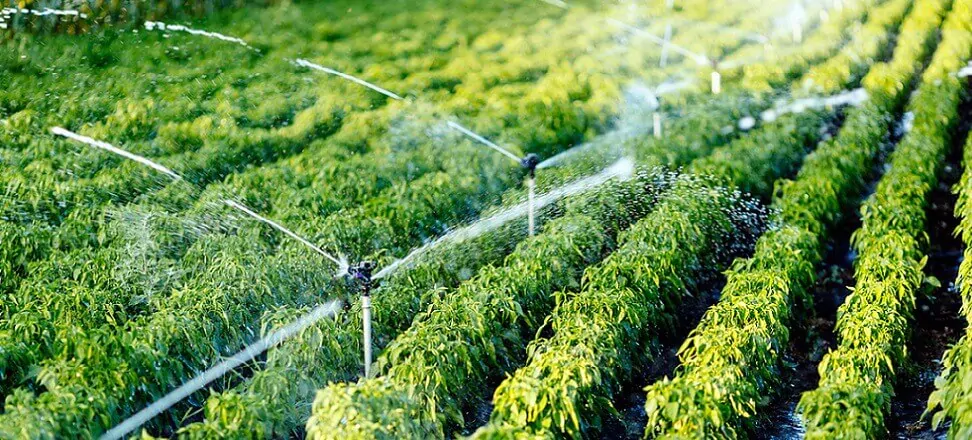Feedback
Water footprint – a way to ensure rational use of water in agriculture
We know that during the year from the surface of Poland drains by rivers into the Baltic Sea about. 30% of the water coming from precipitation. The remainder, i.e. ca. 70%, returns to the atmosphere through evapotranspiration (evaporation). Despite the fact that we “have” a constant amount of water all the time, we are increasingly facing water shortages or droughts in areas where water was previously abundant.
It seems that in connection with sustainable development, in the near future, water footprint indicators/indices should be a supplement to the UN’s published human development index.
Water footprint in agriculture
The water footprint is an important indicator of sustainable management and management of water resources.
In the context of agriculture, the term “water footprint” refers to the amount of water used to produce an agricultural product. It takes into account both direct and indirect water consumption, related, for example, to the production of fertilizer, feed and other products that are used in agriculture.
Thus, the water footprint is the amount of water used in the entire cultivation or livestock production process, from field irrigation and animal husbandry to production and transportation. In other words, the footprint determines how much water is needed to produce a unit of a given product, such as 1 kg of beef, 1 kg of strawberries or 1 l of apple juice.
The global water footprint of agricultural production consists of the water footprint:
- Crops – cereals and plants, including those processed later for feed;
- Pastures – green areas used for grazing;
- Livestock – which consists of such elements as:
- Indirect feed water footprint – the water used to convert cereals and crops, such as legumes, into feed;
- Direct animal water footprint – water used for watering and handling during the animal’s rearing period.
Livestock production generates a larger water footprint than crop production due to the need to supply water not only for the animals raised, but also for the plants that provide their food. The amount of water needed to produce a kilogram of meat will include this one:
- drunk by animals during their lifetime;
- needed to produce the feed that the animals in question ate;
- used to clean the premises where the animals were kept;
- consumed in slaughterhouses;
- consumed for packaging, processing, etc.
Nevertheless, in both livestock and crop production, there are strategies and technologies to minimize the water footprint. These solutions include efficient irrigation systems, optimal water management or the use of renewable energy sources.
Water footprint in livestock production
The water footprint in livestock production refers to the amount of water used in the animal husbandry process, including but not limited to. Pasture irrigation, animal drinking, feed production or meat processing.
The production of meat, milk and other animal products involves a higher water footprint than crop production.
For example, for the daily effective production of 25 liters of milk, the body of a modern cow needs, depending on the housing system, from 75 to as much as 100 liters of drinking water. In addition, each day in the production process, water is needed for washing milking installations and cooling milk (up to 7 l/DJP), for cleaning floors, including in the milking parlor and waiting room (up to 8 – 9 l/DJP). In the case of beef production, several tens of liters of water are used per day for watering 1 DJP, another liters for washing the floors of the manure and walking corridors (4 l/DJP) and the milking parlor and waiting room (as much as 8 – 9 l/DJP).
The abattoir uses 6 to 15 liters of water for each kilogram of meat, or another several thousand liters for each animal.
Water in animal production is also used in the washing and processing of raw material, and in processes such as pasteurization (e.g., milk), sterilization (e.g., eggs), refrigeration (e.g., all portions of raw meat), cleaning and disinfection (e.g., slaughterhouses), and disposal of waste that is generated at each stage of production.
However, the largest amount of water in the animal husbandry process is consumed by feed production. It accounts for approx. 95% of the total water footprint of animal products.
Water footprint in crop production
The water footprint in crop production refers to the amount of water used in growing crops such as grains, vegetables, fruits, etc. It includes the irrigation of fields, the use of water during the process of plant growth and development, as well as the production of crop inputs, i.e. Fertilizers or pesticides. The footprint in crop production can vary depending on the type of crop, geographic location and availability of natural water resources.
The water footprint in crop production is assumed to consist of:
Water footprint (WF) = green WF + blue WF + gray WF
- Green water footprint is the amount of rainwater used that does not become runoff. It is also an indicator of the amount of moisture (from precipitation) in the soil. The green water footprint in crop production can be reduced, among other things. by improving soil and water management techniques in the field.
- The blue water footprint is the amount of water abstracted from surface and groundwater. It is an indicator of resource consumption from rivers, lakes, ponds and groundwater. Includes water used for irrigation. The blue water footprint of crop production can be reduced by increasing irrigation efficiency and using proper timing and amounts of water delivery.
- The gray water footprint is the water needed to dilute contaminants to a safe concentration (such as nitrogen in fertilizers).
Not all gray waters come from blue waters.
The gray water footprint in crop production can be reduced by limiting the leaching of contaminants from the soil, precise and efficient fertilization, and precise application of crop protection products. For organic farming, the gray water footprint is zero.
Blue and green water
The water flowing out of the rivers is the so-called. Blue water – used mainly to meet the needs of the population and industry. The water that goes into the soil is called “water. Green water, which is used by vegetation, including crops.
Can consumers reduce the water footprint from agriculture?
The role and main task of agriculture is to provide food for society. The water footprint, on the other hand, makes it possible to identify agricultural sectors with particularly high water consumption and, under current climatic conditions, which can and even should implement measures to use water resources more efficiently.
With a water footprint, consumers can make comparisons between different agricultural products and choose those that promote more sustainable farming practices and with a smaller water footprint.
It is we – consumers – who indirectly influence what agriculture produces and will produce in the near future.
According to the Grace Water Footprint Calculator(WFC), diet has the greatest impact on what water footprint a person has. Our diet – that is, what we eat – affects water management in the home more than, say, washing ourselves or flushing the toilet.
For more on the food-related water footprint, see the article:“When we export food, do we export water?“.

 Polski
Polski







